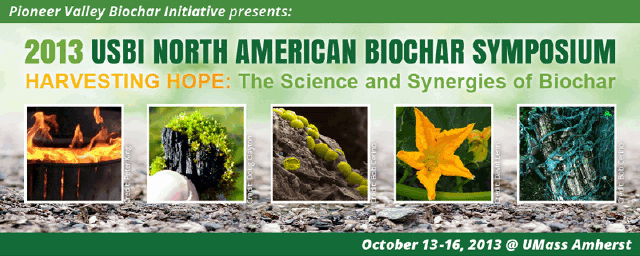Benefits & Uses of Biochar
Biochar in Renewable Energy
Streaming Media
Location
CC 101
Start Date
15-10-2013 3:15 PM
End Date
15-10-2013 5:00 PM
Session Description
Microbial Fuel Cell – M. Rao, high school student
http://www.youtube.com/watch?v=s0Rdrf7tkHA
This novel research studies the performance of biochar cathodes. Microbial fuel cells (MFCs) have the potential to contribute to the increasing demand for sustainable energy. Large-scale application of MFCs is yet to be implemented because of low power generation and high electrode costs. Currently, one of the largest obstacles is the development of a feasible and environmentally friendly cathode. Platinum catalyst cathodes are expensive and make up 60% of the cost of microbial fuel cell. The goal of this research was to determine if biochar, pyrolized organic matter that is a soil amendment, could operate as a feasible cathode in a microbial fuel cell.
Biochar was made out of three feedstocks: mixed wood chips, Douglas fir, yellow pine at different temperatures. By cost, the biochar cathode was 98.4% cheaper than the platinum cathode ($22-44 vs. $1500). The cost effectiveness of the biochar cathode makes it potentially viable if its current densities can be increased. Future research involves testing a broader variety of feedstock as well as developing a biochar/platinum hybrid.
Microbial Fuel Cell – T. Huggins, University of Colorado
http://www.youtube.com/watch?v=45ZNVtpv-40
The high cost of electrode materials is one major challenge facing the full scale application of the microbial fuel cell (MFC) technology. We demonstrate here for the first time that high temperature (>800°C) biochar can be a cost effective and sustainable alternative to traditional granular activated carbon (GAC) and graphite granules (GG) as MFC electrode materials. Using locally available waste-biomass, exothermic manufacturing process, and end of life agricultural benefit, biochar can be manufactured for around 51-365 US$ tonne-1, up to 10 times cheaper than GAC (500-2500 US$ tonne-1) or GG (500-800 US$ tonne-1) and have significantly greater life cycle advantages. The use of biochar as the MFC anode rings in a new era of alternative electrode material options with economic and environmental benefits.
Biochar in Renewable Energy
CC 101
Microbial Fuel Cell – M. Rao, high school student
http://www.youtube.com/watch?v=s0Rdrf7tkHA
This novel research studies the performance of biochar cathodes. Microbial fuel cells (MFCs) have the potential to contribute to the increasing demand for sustainable energy. Large-scale application of MFCs is yet to be implemented because of low power generation and high electrode costs. Currently, one of the largest obstacles is the development of a feasible and environmentally friendly cathode. Platinum catalyst cathodes are expensive and make up 60% of the cost of microbial fuel cell. The goal of this research was to determine if biochar, pyrolized organic matter that is a soil amendment, could operate as a feasible cathode in a microbial fuel cell.
Biochar was made out of three feedstocks: mixed wood chips, Douglas fir, yellow pine at different temperatures. By cost, the biochar cathode was 98.4% cheaper than the platinum cathode ($22-44 vs. $1500). The cost effectiveness of the biochar cathode makes it potentially viable if its current densities can be increased. Future research involves testing a broader variety of feedstock as well as developing a biochar/platinum hybrid.
Microbial Fuel Cell – T. Huggins, University of Colorado
http://www.youtube.com/watch?v=45ZNVtpv-40
The high cost of electrode materials is one major challenge facing the full scale application of the microbial fuel cell (MFC) technology. We demonstrate here for the first time that high temperature (>800°C) biochar can be a cost effective and sustainable alternative to traditional granular activated carbon (GAC) and graphite granules (GG) as MFC electrode materials. Using locally available waste-biomass, exothermic manufacturing process, and end of life agricultural benefit, biochar can be manufactured for around 51-365 US$ tonne-1, up to 10 times cheaper than GAC (500-2500 US$ tonne-1) or GG (500-800 US$ tonne-1) and have significantly greater life cycle advantages. The use of biochar as the MFC anode rings in a new era of alternative electrode material options with economic and environmental benefits.



Bio and Photo
Meghana Rao is a student at Jesuit High School in Portland Oregon and is the Founder and Director of PortlandJuniorScientists.org
Mitchell Tyler Huggins is the Co-founder/Senior Sustainability Engineer at Full Sustainability Consulting, a Research Bioengineer for the U.S. Department of Defense, and a Research Engineer at the University of Colorado Denver focusing on clean tech development in water/wastwater treatment, environmental remediation and bioenergy production.